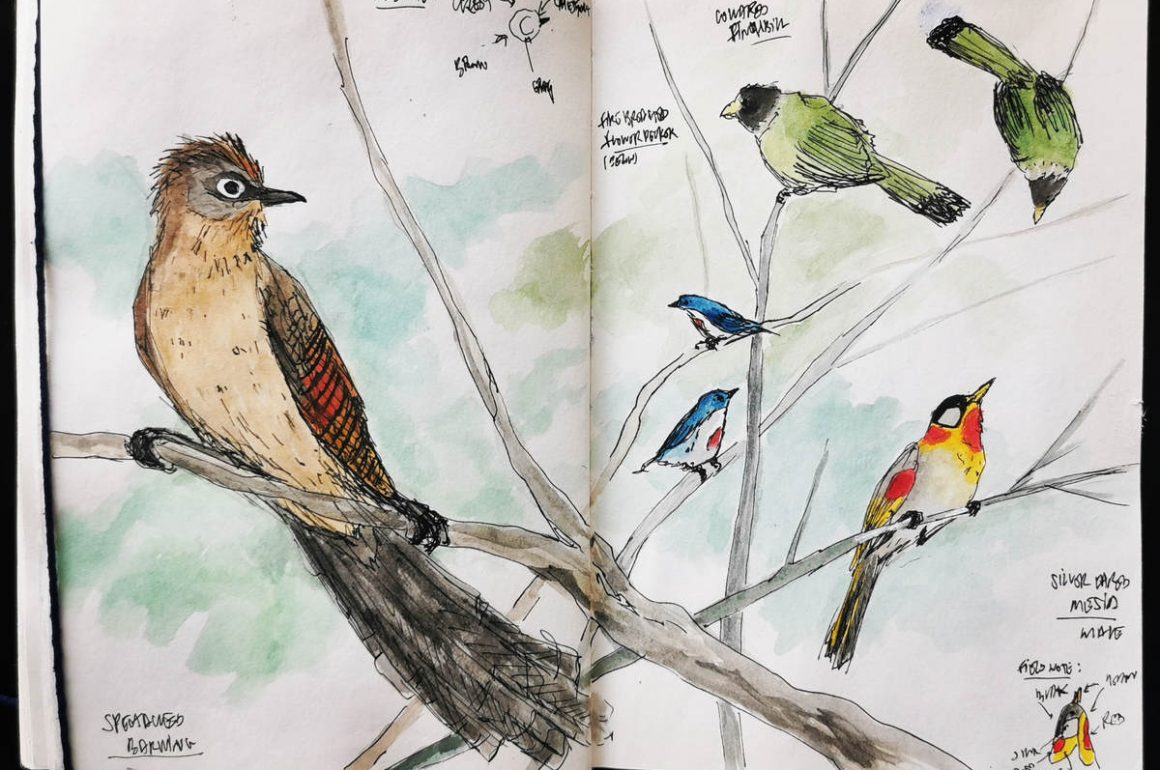
By Louis-Jean Germain
Influenced by his mother, Louis-Jean Germain has long been interested in art, and in recent years, he has become an avid painter of Asian birds. Having earned both a Master’s Degree in Engineering and in Law, Germain works as a manager for the construction industry. Germain has lived in East Asia since 2014.
“Where are my binos?”
I asked myself while I was in the taxi on my way to the airport. For the Chinese New Year 2022 holidays, my girlfriend and I decided to visit the remote areas of Guangxi in the South of China, at the border to Vietnam. The main purpose was to relax, get away from my stressful job, and also to hike in the beautiful mountainous landscape of those wild areas. I used to be an avid birder, but during the last couple of years, because of other hobbies or life choices, I have been birding less and less.
I eventually felt at ease when I found my binoculars in my backpack; I always appreciate watching birds in any new area that I visit. A that point in time, I could not imagine the adventure that I was going to experience and how birds would have rescued me.
On February 3, our plane landed in Nanning. We jumped into our rented SUV Jeep Compass for a trip of 6 days. We headed west to spend our first two nights in the Chongzuo area, in a deliciously comfortable hotel, offering stunning views of the landscape.
On February 5, we arrived at EQuanCun, a small touristic village, 4 km away from Jingxi city in the county of Baise. The village was charming, busy but not overcrowded, with an effervescent river and plenty of restaurants serving goose stew, the local speciality.
On February 6, we went hiking in the WuLing forest park for the whole day, where we surprised 5 males and 2 females Silver Pheasants foraging under large pine trees. When we came back to EQuanCun, in the evening, the village was deserted. Why did all tourists disappear? Why were all shops and restaurants closed? The owner of the hotel told us that a COVID-19 case had been discovered that day a dozen of kilometres from there. At that time, China was strictly applying the zero COVID-19 policy. Isolation was the basic principle. We were anxious – what was going to happen to us?
On February 7, we escaped from EQuanCun in the early morning, getting around a few police stops, until reaching the small city of Hurunzhen at the border between Baise county and Chongzuo county. The road was blocked by the police, making it impossible to continue our way to the airport. During the night, the government announced that the county of Baise was completely locked down, epidemically isolated, from the rest of China. We checked into a hotel available in front of the police blockade. The police knocked on our door, requesting us to stay in that hotel until the Baise county became unlocked. We had no information when the border would re-opened – perhaps within 2 days or perhaps within 5 weeks. We were trapped like birds in a cage.
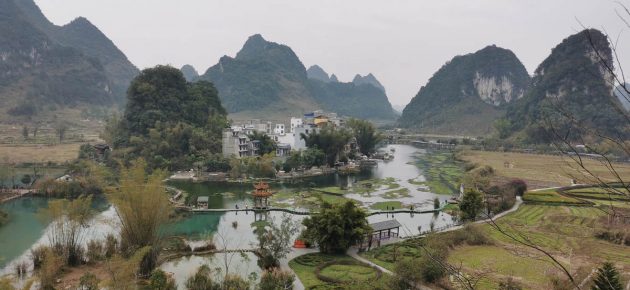
EQuanCun village (Photo by Louis-Jean Germain)
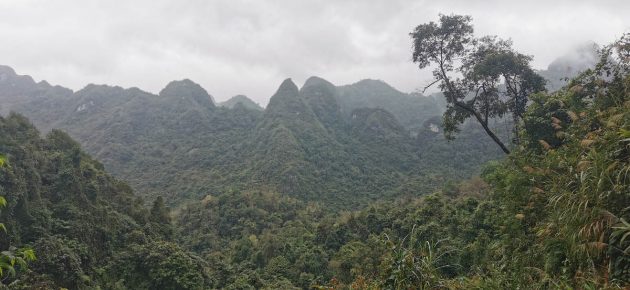
Mountain around Hurunzhen (22.9975112,106.7289038) (Photo by Louis-Jean Germain)
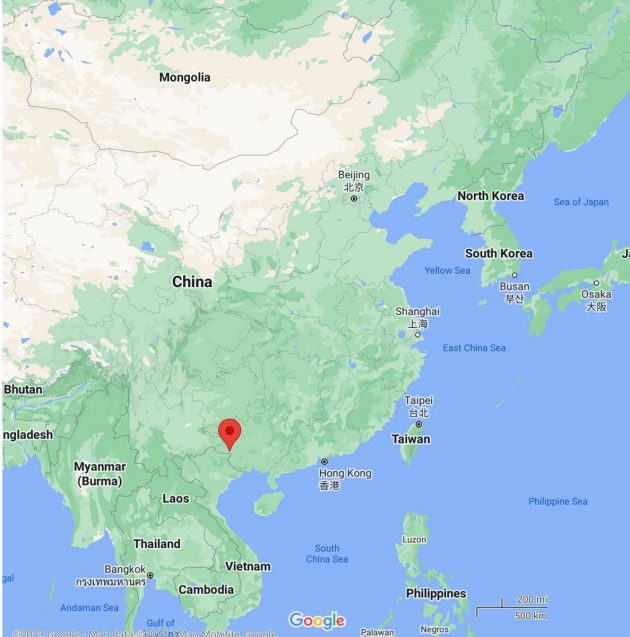
Location of Hurunzhen (red dot) on the map of East China (north toward top) (from Baidu Map)
Fortunately, our area was classified as “opened”, we were free to move around (neither under quarantine nor confined to the hotel). Without hesitation, we started exploring the surroundings. To my surprise, I spotted an Asian Barred Owlet on the same afternoon, on an electrical wire scrutinizing a field, and a Blue-Rumped Pitta, inside a dense forest track. I was astonished as these are magnificent and rare birds.
The next day, we went back to the same place, and spotted a large and bold birds wave, led by Yellow-Cheeked Tit (2), and composed of male Scarlet Minivets (5), Rufous-capped Babbler, Grey-cheeked Nun Babbler and Grey-cheeker Leaf Warbler. Half an hour later, we surprised a flock of Red-whiskered Bulbuls, Black-crested Bulbuls and Blue-throated Barbets (2) resting on a bare tree. My heart was palpitating while watching these oriental birds, this place was magical.
Day after day, I avidly continued exploring the surroundings of our hotel (within a radius of 20 km). Birds became my lifeline. Birds became my way to escape from the stressful feeling of being trapped and having no information when we could be released. Each new day became the chance to satisfy my avid enthusiasm to spot new birds. And, I was not hastened. The time was not running against me, as it usually does. The notion of time disappeared, I was living with the cycle of the sun, day after day. I had the unexpected and rare chance to take all time I needed observing birds serenely.
I have developed a specific way of appreciating birds: I draw and paint them. How do I draw birds? I always draw birds on the field, while observing them, flying, singing, calling, foraging, fighting, socializing… I am specifically interested about the motion and dynamic of birds. Once I spot an individual, I stare at him for about 30 seconds, while it is moving, until all his shapes and gestures become entirely familiar to my eyes. I can then, on a paper, using an ink pen, draw the shape of that individual bird that impregnated the most by memory (I used Hahnemuehle 140g/m2 notebook and Mitsubishi uni-ball eye ub-150 pen). I continue to spot that individual for the touch ups, adding the specific features of that bird (eyebrow, eye rings, covers pattern, crest, bristles…) and take field notes about the colours. I then complete my artwork back in the hotel using watercolour (aquarelle Daler-Rowney). It is a deep intellectual and artistic exercise, which authentically captures my passion and emotion while watching birds. I can fully relate to Francis Hallé, a famous botanist and avid drawer of tropical plants, who describes the necessary time to achieve a drawing as a conversation between the plant and himself. (F. Hallé, ‘Atlas Poetic Botanic’, edition MIT Press, 2018). I was conversing with the birds of Guangxi through my drawings.
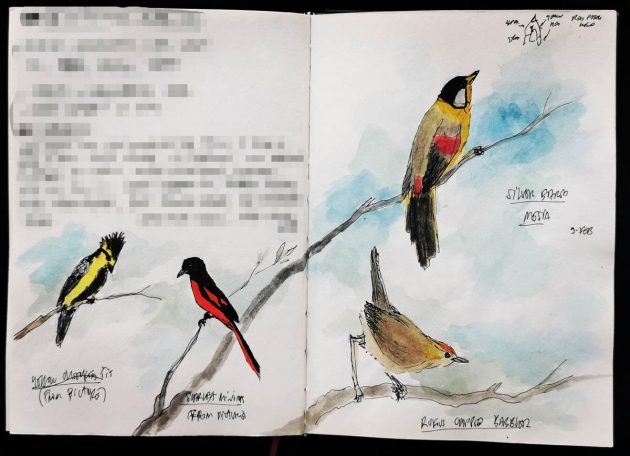
Bird painting by Louis-Jean Germain (ink and watercolour on paper) (From left to right, and top to bottom: Yellow-cheeked Tit, Scarlet Minivet, Silver-eared Mesia, Rufous-capped Babbler)
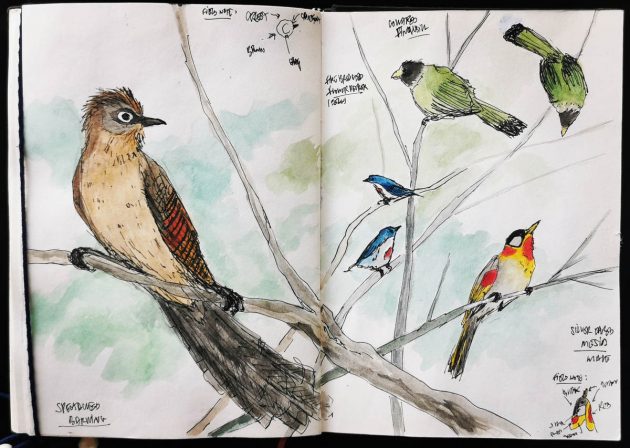
Bird painting by Louis-Jean Germain (extract from notebook, ink and watercolour on paper) (From left to right, and top to bottom: Spectacled Barwing, Collared Finchbill, Fire-Breasted Flowerpecker, Silver-eared Mesia)
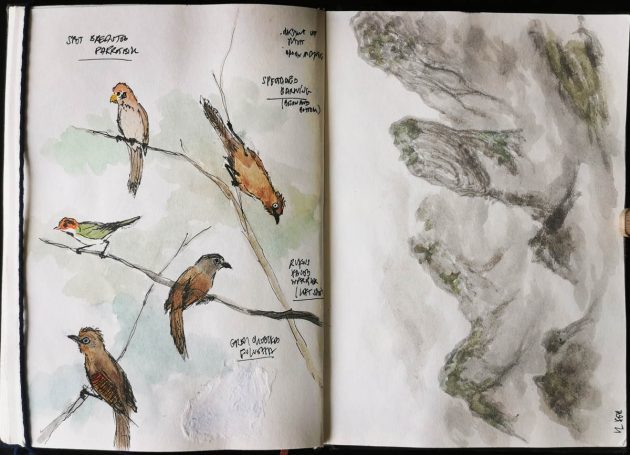
Bird painting on the left and landscape painting on the right side (oriented toward left) by Louis-Jean Germain (extract from notebook, ink and watercolour on paper) (From left to right, and top to bottom: Spot-breasted Parrotbill, Spectacled Barwing, Rufous-faced Warbler, Grey-cheeked Nun Babbler (David’s, Huet’s or Yunnan Fulvetta), Spectacled Barwing)
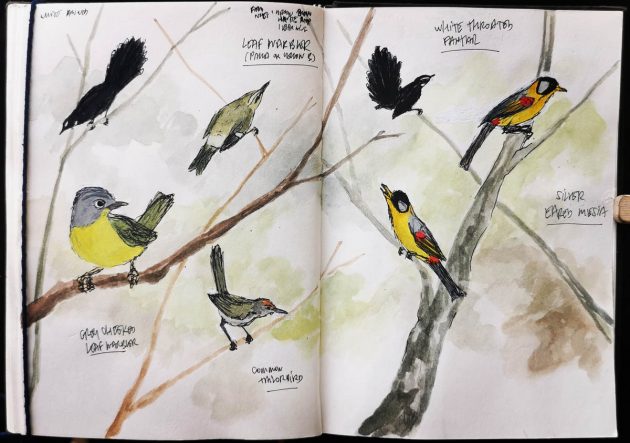
Bird painting by Louis-Jean Germain (extract from notebook, ink and watercolour on paper) (From left to right, and top to bottom: White-throated Fantail, Leaf Warbler (probably Pallas’s), White-throated Fantail, Silvered-eared Mesia, Grey-cheeked Leaf Warbler, Common Tailorbird)
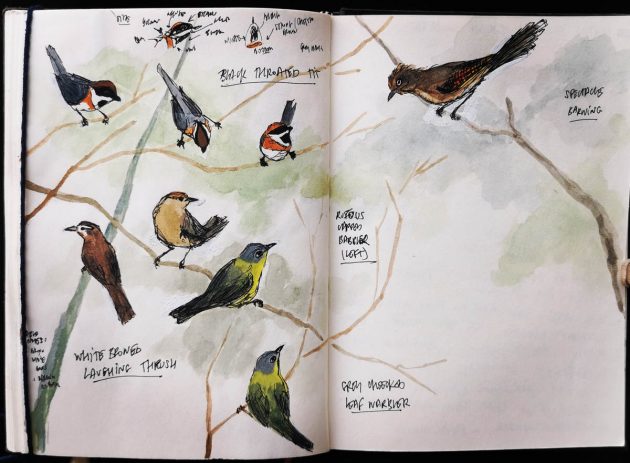
Bird painting by Louis-Jean Germain (extract from notebook, ink and watercolour on paper) (From left to right, and top to bottom: Black-throated Bushtit, Spectacle Barwing, White-browed Laughingthrush, Rufous-capped Babbler, Grey-cheeked Warbler)
I was certainly also moved by the landscape of the mountains of Guangxi. This mountainous area, which forms part of the Yunnan-Guizhou Plateau, is described as a karst landscape by Wikipedia (narrow peaks formed by erosion of limestones). I sat for hours, dreamily watching those rocks raising to the sky, covered by the dense primary vegetation of this subtropical area. Each day, the landscape was different, the mountains appeared to change forms and colours, my impressions were influenced by the sunlight, the fog, clouds or rain. I sat for long hours along the road or on a mountain track, using my paint brushes and ink to catch the deep emotion and essence of those mountains, like in a Shanshui painting.
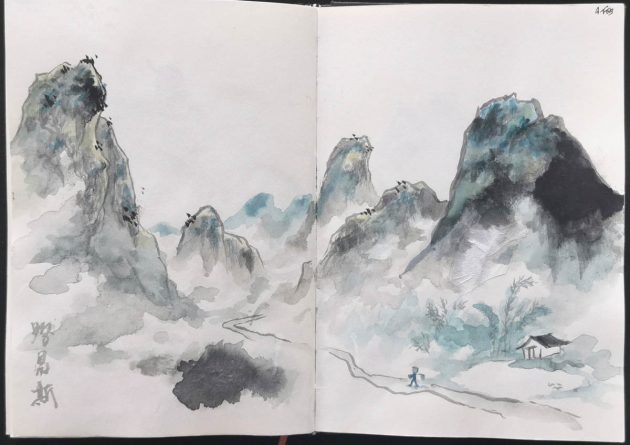
Mountains around Chongzuo (22.6998898,106.9250517) – Landscape painting by Louis-Jean Germain (ink and watercolour on paper)
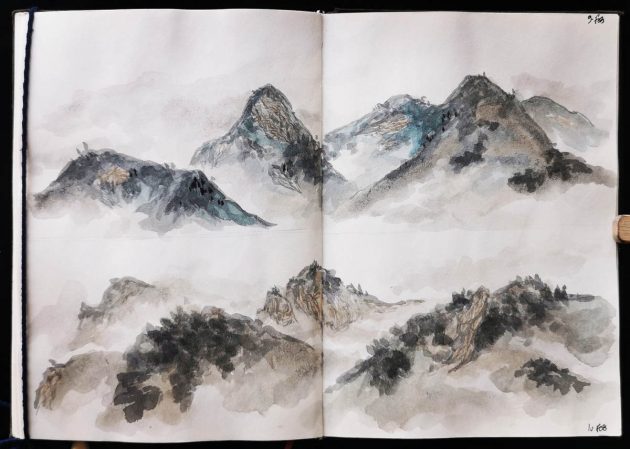
2 paintings of Mountains around Hurunzhen (top painting: 22.9686603,106.7155735; bottom painting: 22.9947561,106.7339101) – Landscape paintings by Louis-Jean Germain (extract from notebook, ink and watercolour on paper)
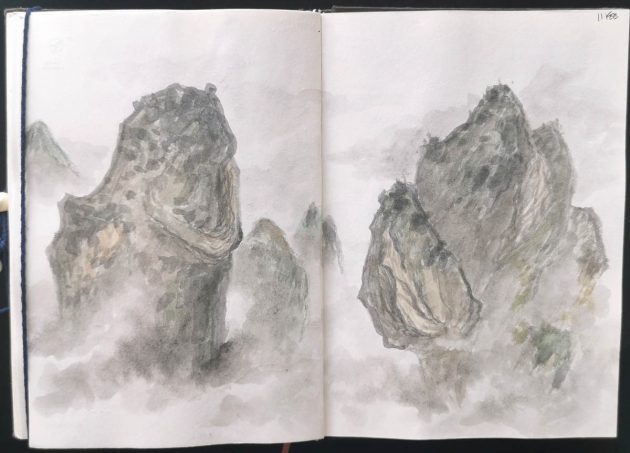
Mountains around Hurunzhen (23.0259006,106.7553047) – Landscape painting by Louis-Jean Germain (extract from notebook, ink and watercolour on paper)
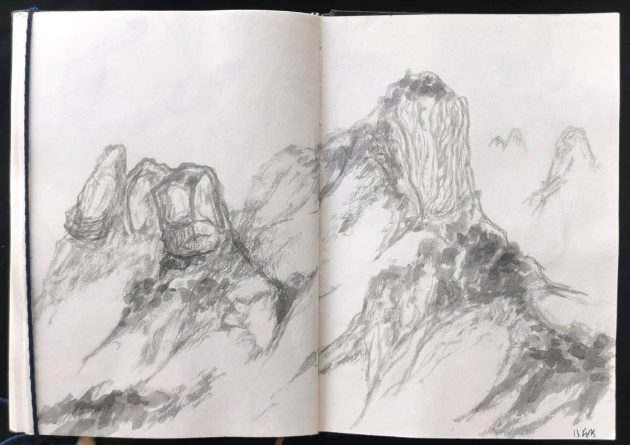
Mountains around Hurunzhen (22.9683439,106.6929363) – Landscape painting by Louis-Jean Germain (extract from notebook, ink and watercolour on paper)
The area of Hurunzhen (Gangxi, China), where we were locked in, is inhabited by local people, divided into numerous small villages at the feet of these mountains. Most of them were living on non-mechanized farming, which is limited to the few flat areas between the mountains. Only rarely mountain flanks were exploited as forestry plantations, probably by entrepreneurs using excavating machines to create tracks for trucks in the mountains (certainly not affordable for the local people). Occasionally, mountain flanks were exploited for manganese ore mining; I noted several manganese processing plants located around Hurunzhen. The local people were scared of our presence, perhaps stressed out because this lockdown seemed incomprehensible in their eyes, and also perhaps afraid that we could decide to use their land for forestry plantation or mining, which would compel them to expropriation and emigration to an uncertain life. However, as soon as I was saying Kan Niao (“I watch bird”) and showing my paintings, a smile of happiness illuminated their faces. I was accepted in the mountains.
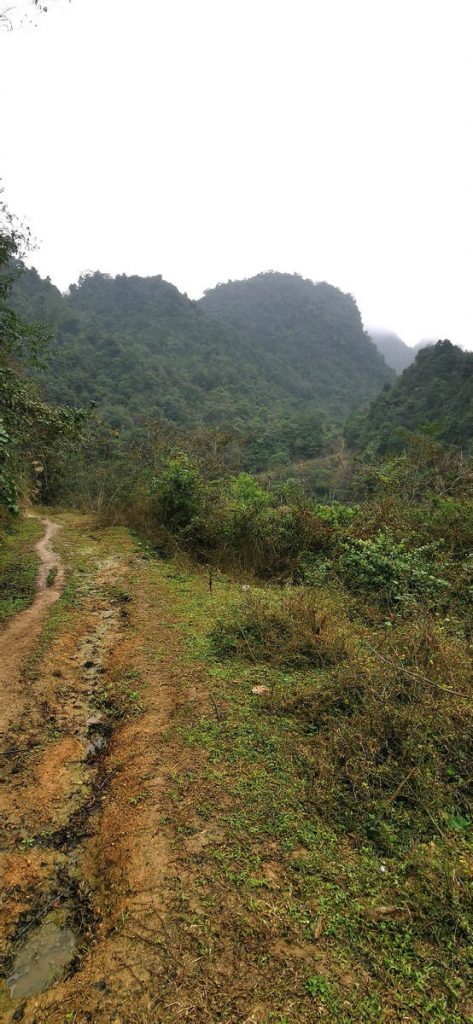
Mountains around Hurunzhen (Photo by Louis-Jean Germain)
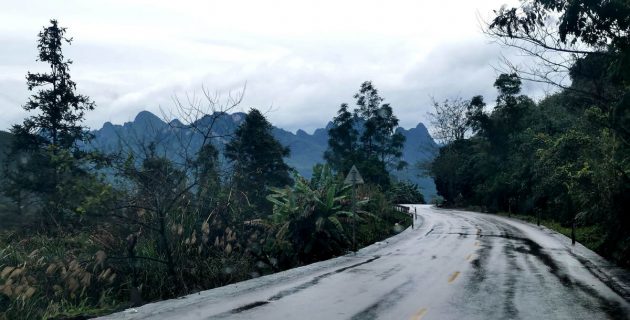
Mountains around Hurunzhen (Photo by Louis-Jean Germain)
The size of some bird waves I observed in Guangxi amazed me, reaching up to 200 individuals or more. Birds of different species gather in bird waves to improve foraging efficiency (the insect escaping one bird will most likely be caught by another bird of the wave) and increase protection against predators. When I meet such a big wave, I stop using binoculars and just watch it with my bare eyes. A bird wave is a firework of mixing colours, a cacophony of songs and calls of overexcited birds. A bird wave can be observed discretely, at individual bird level, or holistically, as a whole. A bird wave is the manifestation of a complex entity, displaying simultaneously order and disorder, constantly self-creating and self-disintegrating, recursively self-re-shaping. A bird wave appeared to me as a single gigantic wild animal, inhabiting the mysterious mountains of Guangxi. I took a vivid pleasure to walk alongside the road following large bird waves. In the beginning, the birds are suspicious of my presence, alerting and diverting their way around me, but after a while, the reluctance faded, and I became part of the bird wave.
On February 15, after having followed a large bird wave for an hour, my girlfriend jumped over to me and said: “We are free to go”. The authorities finally decided to release us (thanks to the many hours she spent on the phone, and the support of the French consulate). One hour later, we were signing our quarantine release certificate, and the policeman opened the gateway of the highway allowing us to drive to Nanning, to fly back home. Suddenly, I felt sad to leave those beautiful mountains, which henceforth I belonged to.
Post Scriptum:
- Upon arrival in Qingdao, my home, the authorities welcomed us by requesting a quarantine of 7 days in a hotel and 7 days at home. This period offered me the time to write this article.
- The facts of the story have been slightly simplified and arranged for the sake of the article.
Bird list (not exhaustive) based on IOC World Bird Names version 11.2:
Silver Pheasant
Greater Coucal
Pheasant-tailed Jacana
Black-winged Kite
Asian Barred Owlet
Blue-throated Barbet
Blue-beared Bee-eater
Blue-rumped Pitta
Scarlet Minivet
White-throated fantail
Fire-breasted Flowerpecker
Black-throated Sunbird
Greyish-crowned Leafbird
Scaly-breasted Munia
Yellow-cheeked Tit
Cinerous Tit
Common Tailorbird
Grey-eyed Bulbul
Red-whiskered Bulbul
Black-crested Bulbul
Collared Finchbill
Black-throated Bushtit
Grey-cheeked Warbler
Leaf Warbler (probably Pallas’s)
Rufous-faced Warbler
Spot-breasted Parrotbill
Rufous-capped Babbler
David’s, Huet’s or Yunnan Fulvetta (Grey-cheeked Nun Babbler)
White-browed Laughingthrush
Silver-eared Mesia
Spectacled Barwing










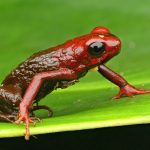
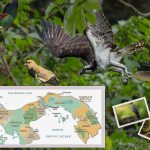
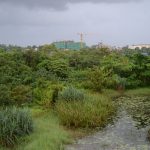
Wonderful journey, colorful life. Hope one day I can enjoy the nature as you did
You discovered another beauty in the journey when we had to pause. It’s interesting to know so many birds. And very nice paintings!
Congratulations for this paper that share your insights during the lockdown and your love for birds and birding.
bravo?
The birds are as natural as they were living. The mountains are range by range. Just as if I were there to see the beautiful scene.
La magie du dessin nous emmène au coeur de ces montagnes d’Hurunzhem à la rencontre de ces oiseaux si variés et colorés . C’est comme un voyage initiatique où la chance serait d’appartenir peu à peu à un univers insoupçonné en traversant le miroir d’une réalité aliénante.
Really inspiring story ! Thank you for sharing it here
Although I’ve been living in China for almost a decade I never expected that Guizhou backcountry would host such a rich and colorful wildlife.